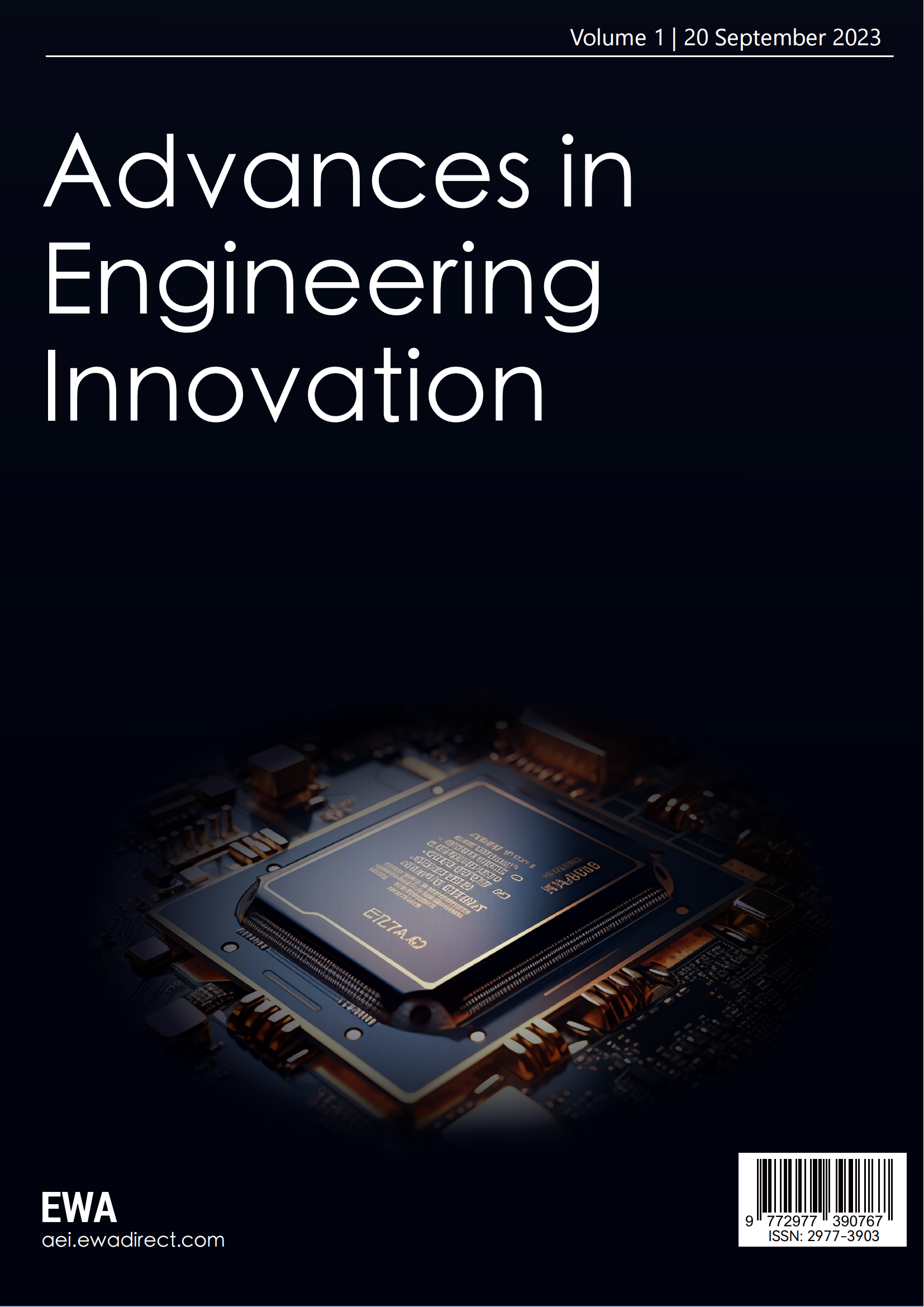1. Introduction
1.1 The Grand Canal
The Grand Canal, or the Beijing-Hangzhou Canal, was excavated in Sui Dynasty as a giant irrigation project. With a history of over 1,400 years and a length of 1,794 kilometers, it is one of the world's oldest canals and is the longest artificial river [1]. The canal goes from Beijing in the north to Hangzhou, the capital of Zhejiang Province, where the canal connects with the Qiantang River. To protect and revitalize the Grand Canal, the immense canal was listed in the World Heritage Candidate in China [2].
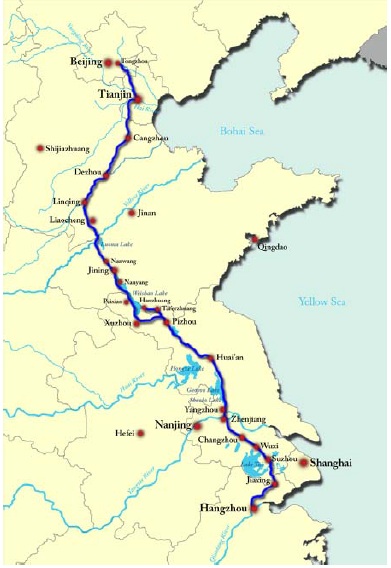
Figure1.Routine of Grand Canal
The main role of the Beijing-Hangzhou Grand Canal is both transport and cultural. The Beijing-Hangzhou Canal, flowed through Tianjin and other four provinces, joined the five larger rivers systems from different directions, facilitated transport of foods and goods from south to north in ancient China, consequently the corridor along the canal developing into an important economic belt [3].
In the past times, the Grand Canal served as the main artery and augmented economic and cultural communication between north and south China. The Grand Canal also contributes to cultural exchange and political integration to mature between northern and southern part in China. Besides, the waterfront culture created by the ancestors is valuable heritage, abundant in social, cultural, environmental and economic value [4].
1.2 Background
1.2.1 The Grand Canal cultural heritage. (1) Product culture:
In the canal basin, vernacular paper cutting, fans, silk, Hang scissors, tobacco, tea, and nuts were of prosperous trade [5].
(2) Water transport culture:
The canal was an essential passage for the shipping grain from south to Beijing.
(3) Tea and opera culture:
Chinese folk-art forms and acrobatic drama performed in tea houses has developed a unique tea and opera culture by the waterfront.
Intangible Cultural Heritage: folk music/Hangzhou drama
(4) Tourism culture:
From the ancient times, the Grant Canal has been used as crucial channel for tourism, especially opening a fascinating window for foreigners.
(5) Folk customs:
The waterfront of the canal was ideally inhabited for residents so much of folk customs are distinct l influenced by their special lifestyle.
(6) Landscape culture:
The delicate buildings with white walls and black tiles along the canal, numerous scattered bridges and winding rivers unfolded the characteristic in Jiangnan.
Bridge culture: eleven ancient bridges with distinguished styles are well kept over the canal [6].
(7) Commercial and waterfront culture:
Since the Tang dynasty, the canal burgeoned thriving business, many shops lining on both sides and consequently forming vibrant water street.
In summary, although the canal no longer reproduces the kind of leisure life scene as in ancient times, but it leaves precious historical and cultural memories and relics, providing a reference for to rebuild and reconstruct a modern leisure and recreation space.
1.2.2 Research issues. (1) Issues of historic blocks along the Grand Canal Hangzhou:
The 1,400-year-old Grand Canal is respected as China’s Ancient lifeline and is still in use today, but it is in trouble nowadays.
1) Destruction of the natural environment and degradation of ecosystem
With the development of industry, hundreds of plants were planted along discharging toxic sewage directly into the canal. Meanwhile, as booming of urbanization, the population of residents near the canal underwent a dramatic growth, by which leads to a huge increase of domestic sewage.in conclusion, the water of the canal was heavily polluted and eventually destroys the living of organisms and human beings [7].
2) Disorganized land use
Without orderly master planning, the land use along the canal was complicated and in chaos. Most of land was occupied by warehousing space, and residential land and industrial areas were disarrayed, which adversely impact the tourism. Without proper zoning, common land was in scarcity that the green or public open space for leisure is deprived, which blocks the access to the waterfront. In addition, due to deterioration of living environment and insufficient infrastructures, most residents were obliged to move out of the neighbor [8].
Further, the entire landscape is cut into pieces and historical buildings were derelict and seriously damaged.
3) Recession of canal culture
The canal culture was on decline with the depression of the shipping function of the canal. The original planning overemphasized its functions of transport and commerce, but failed to recognize its culture significance as well as develop culture industry [9].
(2) Location of historic districts along the Grand Canal
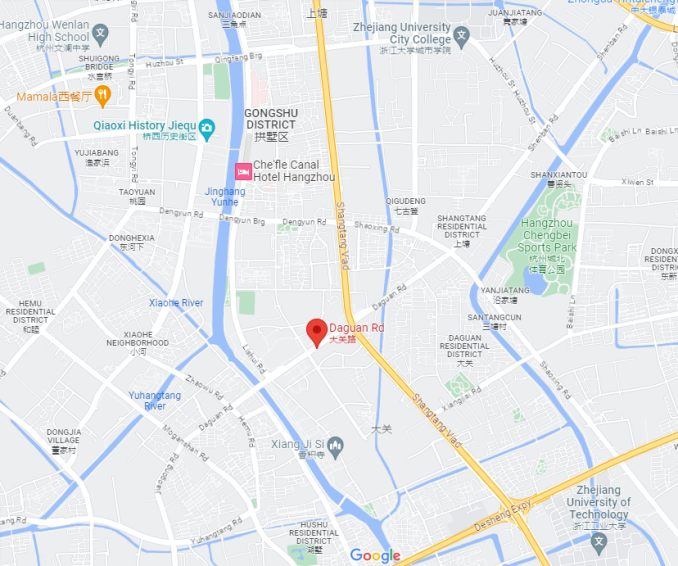
Figure2. Location of historic districts
As is shown is the map, there are three main historic blocks along the canal:West Bridge Street Historic Block, Xiaohe Street Historic Block Dadou Road Historic Block.
1.2.3 Profile of planning concepts. (1) Overall planning strategies:
1) Ecological remediation:
The canal is cleaned by biological and chemical methods and laws are formulated to control industrial swage discharge. Besides, miles of green ways are added along the canal, which not only revitalizes the eco-environment but also enhance the enhance the permeability and accessibility whole waterfront site [10].
2) Restoration of historic blocks:
The original terrain is kept and most of ancient architectures or buildings with cultural values are kept as well as time-honored bridges are repaired, restored. Further, some parts of the dilapidated houses are reconstructed or reconsolidated [11].
(2) Planning guidelines of historic districts along the Grand Canal in Hangzhou:
Table 1. Different historic districts
Block name |
Planning objectives |
West Bridge Street Historic Block |
Rehabilitation of a derelict industrial heritage site Chinese medicine and health care themed block |
Xiaohe Street Historic Block |
Marketplace culture themed block Remediation and maintenance of folk customs and original residence along Grand Canal |
Dadou Road Historic Block |
Zen-couture and foods themed block |
2. Case study of West Bridge historic districts along the Grand Canal --Take West Bridge Street historic block and Dadou Road historic block as examples
2.1 West Bridge Street historic block—Rehabilitation of a derelict industrial heritage site
2.1.1 Location and introduction. West Bridge Street historic block is located on west side of the Gongchen Bridge, hence the name. It borders from Xiaohe Road in the west to the east of the Grand Canal, extending from Hangzhou First Cotton Mill warehouse to Deng Yun Road in the south [12].
The block covers total land area of 72900m2.Early in Tongzhi Period of Qing Dynasty, it was a busy ferry terminal for commerce and business trade in Gongchen Bridge region. The block well preserves the vernacular dwellings along the canal in Late Qing Dynasty and early Republic of China period as well as a large number of relics from modern industry [13].
2.1.2 History and issues. Gongchen bridge is the first stop Grand Canal in Hangzhou northward. In Later Qing Dynasty, the establishment of mills and the booming of shipping greatly prompted local economic and cultural development. It was a time when businessmen, dock porters, factory workers, civilians lived and mixed together, resulting in a diverse social structure as well as various architectural styles.
The region is derelict due to the loss the status as transport tub and depressions of industry
(1) Abandoned industry area
Plants are relocated and the pies are abandoned, only leaving old and useless machines. In addition, the original roads in industry area were out of use which are very wide and mainly for transportation of industry in the history, and had no contribution to the public circulation now.
(2) Lack of public space, facilities along waterfront and inner site
Some industry buildings and warehouses were built close to the waterfront, so that there was little public space along the waterfront for people to go close to water.
For the aging infrastructure and deficiencies of municipal facilities, original dwellers tended to move to new districts. Also, the historic features and local characteristics were significantly damaged.
(3) Design narrative
1) Planning goal
An integrated complex historic block of residence, commerce, creativity and tourism is endowed with Modern industrial culture, dwelling culture as well as transportation culture.
2) Planning concept—retain and repair the spatial texture.
The planning mainly centers on re-division of the previous districts as well as the transportation routine
Zoning:on the condition that keep the natural terrain and emphasis of local culture, the block are divide into museum zone, living zone and commercial zone. More importantly, the district still serves for residents where folk customs and lifestyle are well inherited and preserved
Adjustment of traffic-based on the original road system, the external transport is optimized in more reasonable way since some historic roads are no longer in use.in addition, streets for residents and tourists are separated.
(4) Sustainable strategies for rehabilitation
Renovation of industry area----cultural and creative industries cluster
Profile of the regeneration planning
The core of the redevelopment is to symbiosis of industrial and creative culture.
By fully take the advantage of the old industry area and adding new elements so as to keep the history and improve the district value.
2.1.3 Loft49---Canal art creative loft park. The park is designed with two parts—creative industry base and the green zone, aiming to blend creative industry with leisure functions.
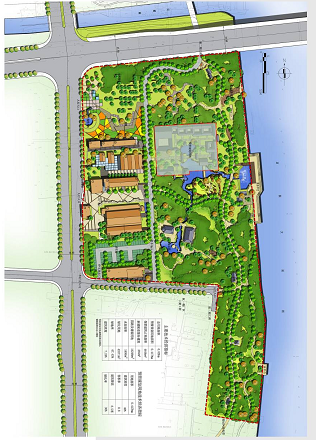
Figure 3. Master planning of Loft park
Creative industry base is transformed from the Changzheng chemical plant where nearly 30,000m2 are conserved. Besides, the exterior and interior of the plants are repaired and there are newly built landscape sketches according to surrounding conditions.
In the context of cluster of creative industries, the green zone not only provides splendid working environment and exhibition space, but also functions as open recreation space for residents. Making reference to the canal culture, artificial circulating water systems are introduced into the park to enhance the waterfront accessibility. Also, parts of relics of plants are reconstructed as landscape sketches.
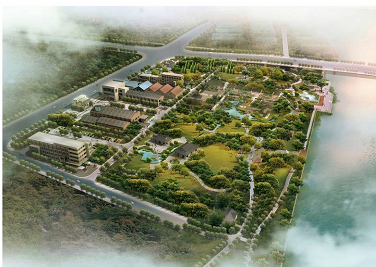
Figure 4. Aerial View of Loft park
Reusing remaining factories and warehouse and inspired by the industrial history, a loft park is designed to be a cluster of cultural and creative industries.
With spacious studios, quiet environment and cheap rent, loft 49 has attracted for nearly 20 art and design companies involving visual design, exhibition, IT, restaurants and the like.
2.1.4 Canal world. Grand Canal World covers an area of 31600m2, which preserves nine old workshops listed among the historic buildings under municipal protection.it is designed. Now it has developed into a culture, fashion and leisure experience center that is equipped with star-rated movie theater, international fashionable brands, restaurants and entertainment facilities.
2.1.5Museums—from derelict factories to national museums. Museum shows the traditional culture.
Features:
Function conversion of old buildings: Repair, reconstruct and face-lift the destroyed buildings to meet the standard of national museums and keep valuable characteristic and structure.
Adjust the layout and construct new buildings constituent to the traditional architectural style
Using traditional and modern building materials Interactive workshops, studios, lectures and live shows: inherits of intangible cultural heritage such as fans and umbrella are invited to hold exhibition and reproduce the process of manufacturing. The museums display the local cultures deriving from daily life with multi -sensational experience enables tourists and citizens get a clear picture of the canal culture.
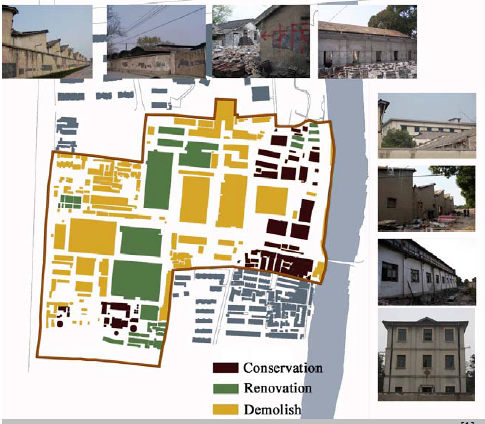
Figure 5. Redivision of land use
First, according to different conditions of buildings and land use, the districts are suggested with conservation, renovation or demolition. In particular, regarding to conservation, the fabric and block form are repaired and retained with new elements.
Secondly, Landscape will be combined with initial and new architectures in physical forms.
Landscape sketches are overriding important constituents to the historic blocks, the details of which helps to narrated and retell the stories to the modern people.
Along the canal some of original docks and barges are kept and some damaged are restored.
Further, designers make fully use of collapsed or damaged structures as well as creates sculptures referring to the industrial relics for the purpose of recalling people’s memory of the ancient relics and responding to the local culture. For example, greenways are built to link the waterfront as well as soft traffic.
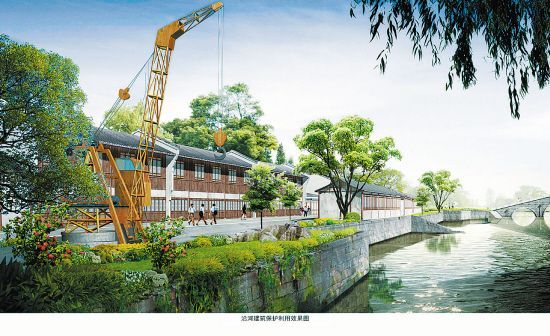
Figure 6. Blend industrial culture with greenery
By rebuilding demolished temples and re-hosting temple festivals annually, traditions and customs are recovered and bring more people back to the old district.
Inns, original shops with time-honored brands are introduced or reopened to revitalize the local commerce
2.2 Dadou Road historic block
2.2.1 Location. Dadou Road historic block is mainly round Dadou road, bordering on the former customhouse in the North (Daguan Road), Fuyi Granary in the South (Xiangjisi Lane), Lishui Road in East and the Grand Canal in the west.
As one of the few old blocks that still preserve original visage, the block covers an area of 95,000m2, including some old lanes.It was the Hangzhou’s trade center for fish, rice, paper and fruits in the past, which recorded the past bustling economy and culture.
2.2.2 History and issues. History:
Dadou road has been developed since Ming Dynasty, which was 1,100 meters long, 5 meters wide. Later in Qing Dynasty, the establishment of bazaar as well as a government-run barn stimulated the area to be the center of trade, commerce and warehouses, where numerous shops and piers lining along the canal.
Problems:
As the decline of the government- run barn and the transportation, old residential housing are without maintenance and turn out to be shabby. In particular, some culture relics are destroyed and lose the identity.
2.2.3 Design narrative. (1) Planning goal—combination culture with food
Now Dadou Road Historic Block has developed into a historic culture and foods themed block that is integrated by cultural leisure, commerce, tourism and residence.
(2) Planning structure
One belt —Canal visual corridor
Though face-lifting and adjustment, the original closed belt mode are opened into large open space.
Two roads and three lanes-The historic road systems and the distribution of lanes are well maintained to be the framework of Dadou road historic district.
Three zones: Residential area/warehouse protection zone/ Zen temples and cultural tourism zone.
2.2.4 Strategies for rehabilitation-- One temple, one market, one street. One temple: By rehabilitation of Xiangji Temple, Buddhist cultural can be emphasized and regenerate.

Figure 7. Overview of the new planning
Xiangji Temple is the only pagoda of the Qing Dynasty in Hangzhou.
But in fact, pictures about Xiangji Temple are rarely recorded, therefore, a bold and innovative ideas are adopted to the transformation
One market: In line with the renewal of Xiangji Temple, the old warehouses of the national silk plants are utilized as galleries for Buddhist cultural exhibition and other art show as well as luxurious hotels
One street:In addition to restoration of old buildings, inns, town houses and various canteens especially vegetarian restaurants are offered to combine commerce with culture.
2.3 Further planning
Night lighting and nightscape design is added in the remediation plan of Hangzhou section, which makes the canal district more attractive and liveable.
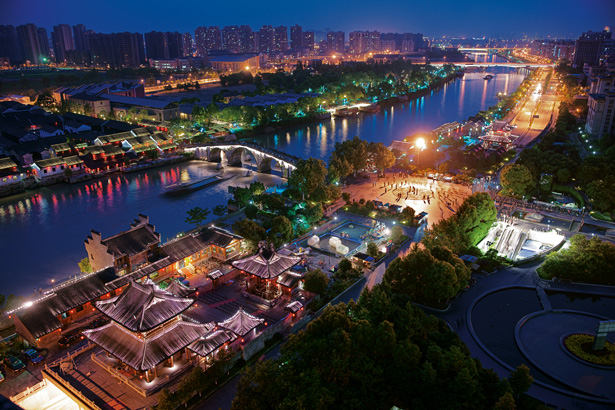
Figure 8. Night scene of the Great Canal
Water public transport system: The government plans to extend the routine of water taxi aim to enhance the linkage between down town and suburban
Canal Business District Project--- Grand Canal CBD
In the Dadou Road historic block, Canal Business District Project is implemented to build a Grand Canal CBD in2010.To the south part of Daguan road, Metro Line 3 will cross the entire north-south Grand Canal CBD. Buildings along Daguan Road are linked by underground walkways and connect with MTR stations so people have easy access to shopping malls without going out of the MTR station. Besides, Xiangji temple station and Daguan Road Station will be an integrated complex of business, office and residence. Fully taken advantage of the Grand canal ,Zijin park are design with water features as well as plentiful open green space.
3. Conclusion of renaissance and renewal of historic districts along the Grand Canal in Hangzhou
3.1. Successful experience
3.1.1Respecting to existing block pattern and original lifestyle. Based on the above discussion historic blocks, the renovation project focuses more on retaining and restoring the old buildings than building new architectures.
In fact, keeping original living environment is not only eco-friendly and energy-saving, but also helps to continue folk customs. It is the residents and their distinct lifestyle that inherit local culture and traditions, by which the blocks will never die.
3.1.2Function exchange. The historical blocks along the Grand Canal in Hangzhou were once the commercial and industrial centers in ancient times, where valuable relics remain. History of old districts is further excavated by reusing the relics and adding new elements. Besides, new industries such as creativity and culture industry as well as F&B, which has little impact on environment, revitalize the area and realize the land value as well as contribute to local economy.
3.1.3 Diversified positioning. Three blocks are targeted with different features which will avoid competitions between them and cater for different customers.
3.1.4Permeability and Accessibility. Cultural linkage: the renewal represents culture from traditional to modern by emersion.
Physical linkage: The existing transportation system is reorganized and the connectivity between the industry areas and surroundings, as well as inner areas is enhanced, by which more tourists and residents will be attracted into the area.
3.2 Deficiency and recommendations
Firstly, it is inappropriate to rebuild old buildings with modern materials.
Secondly, the reconstruction is lack of public engagement. The renaissance of historic blocks is mostly governmental-oriented action and without suggestions or consultation with the public.
3.3 Critical thinking of revitalization of old urban historic zones
3.3.1 Variety and mixed use in program. On one hand, the old urban historic zones retain local history but it may become less attractive as the decline of the old zones. So providing innovative programs with history helps rebuild the popularity among citizens.
On the other hand, coupling land-canal functional spaces enable the taping the value and potential of the old district. In particular, organic organization and growth of terrain, waters, road system with multiple functions is flexible to urban development.
3.3.2 Keep history and terrain in sensitive way. Regard to the interesting old buildings, permanence and renovation rather than demolition or building new ones are highly recommended. Besides, signature architecture and identity need to be kept as the witness and story-teller. Also, new buildings are expected to design in context of the whole urban historic zones.
3.3.3Sharing with the public. During the planning process, public participatory is required for place-making.
Besides, creating the public space and accessibility will make the old district a vibrant and animated place.
4. Discussion and conclusion
In a word, renaissance and renewal of historic blocks needs dig the cultural and economic value, and is promoted with modern culture, production, services, and resources. Also, reconstruction and permanence of the old districts as well as the combination of history and culture in the environment surrounding, play a vital role in initiating the culture of the city.
References
[1]. Chen Yuchen, Shen Lingyi & Shi Xuhua. (2023). Urban renewal evaluation method based on fuzzy analytic hierarchy process - taking the Hangzhou Duanqiao West Historic District of the Canal as an example. Urban Architecture (14), 82-84+99. doi: 10.19892/j.cnki.csjz.2023.14.20.
[2]. Zhang Yiling & Cao Chaochan. (2023). Research on the empowerment of textile intangible heritage industry in the Canal Cultural Belt (Hangzhou Section) from the perspective of cultural tourism space. Art Education Research (13), 73-75.
[3]. Mo Chen,Jiacan Wang,Jing Sun,Fang Ye & Hongyan Zhang.(2023).Spatio-Temporal Distribution Characteristics of Intangible Cultural Heritage and Tourism Response in the Beijing–Hangzhou Grand Canal Basin in China. Sustainability(13). doi:10.3390/SU151310348.
[4]. Zhang Shuying,Liu Jiaming,Pei Tao,Chan Chung Shing,Wang Mengdi & Meng Bin.(2023).Tourism value assessment of linear cultural heritage: the case of the Beijing–Hangzhou Grand Canal in China. Current Issues in Tourism(1). doi:10.1080/13683500.2021.2014791.
[5]. Li Shuhan,Wang Changsong & Fu Xiaoxiao.(2023).Exploring the cultural heritage space adaptability of the Beijing–Hangzhou Grand Canal based on point of interest data. Landscape Research(1). doi:10.1080/01426397.2022.2136367.
[6]. Xia Yuke.(2023).Impact of green space on residents' wellbeing: A case study of the Grand Canal (Hangzhou section).. Frontiers in public health. doi:10.3389/FPUBH.2023.1146892.
[7]. Li Shuhan & Wang Changsong. (2021). Research on the sound landscape perception of the cultural heritage space of the Beijing-Hangzhou Canal - Taking the Dadou Road Historical and Cultural Block in Hangzhou as an example. Urban Development Research (11), 10-15+21.
[8]. Huang Hui & Zhao Hangfei. (2021). Research on the construction of language landscape on both sides of the Hangzhou Canal. Journal of Qiqihar University (Philosophy and Social Sciences Edition) (11), 69-74. doi:10.13971/j.cnki.cn23-1435/c .2021.11.018.
[9]. Lai Xingyu, Huang Liyao, Yao Chengmiao & Wang Xin. (2021). A preliminary study on the setting of refined experience routes in urban space - taking the section from Maiyu Bridge to Daguan Bridge on the Hangzhou Canal as an example. Architecture and Culture (10), 99 -100. doi:10.19875/j.cnki.jzywh.2021.10.036.
[10]. Liu Jing, Chen Zhiyuan, Jin Shengjiang, Wu Bian & Wang Hua. (2021). New perspective on spatial governance of water environment in the Hangzhou Canal Basin. Chinese Urban Planning Society. (eds.) Spatial governance for high-quality development—— Proceedings of the 2020 China Urban Planning Annual Conference (03 Urban Engineering Planning) (pp.21-31). China Construction Industry Press.
[11]. Chen Yuchen. (2021). Research on the evaluation system and strategy for the construction of industrial heritage corridor in the Hangzhou section of the canal (Master's thesis, Zhejiang University). https://kns.cnki.net/KCMS/detail/detail.aspx?dbname =CMFD202201&filename=1021778432.nh
[12]. Chen Nuo. (2021). Renovation and utilization of industrial buildings along the Hangzhou section of the Beijing-Hangzhou Canal. Anhui Architecture (01), 44-45. doi:10.16330/j.cnki.1007-7359.2021.01.018.
[13]. Yu Xinmiao, Qin Luofeng & Qi Aifei. (2012). Research on the reconstruction and renewal model of historical blocks - taking Hangzhou Hefang Street, Southern Song Dynasty Royal Street and Xiaohe Zhi Street as examples. Architecture and Culture (05), 77- 79.
Cite this article
Zhou,L. (2023). Excavation, emersion, permanence-- A case study of renaissance and renewal of historic blocks along the Grand Canal in Hangzhou. Advances in Engineering Innovation,1,57-70.
Data availability
The datasets used and/or analyzed during the current study will be available from the authors upon reasonable request.
Disclaimer/Publisher's Note
The statements, opinions and data contained in all publications are solely those of the individual author(s) and contributor(s) and not of EWA Publishing and/or the editor(s). EWA Publishing and/or the editor(s) disclaim responsibility for any injury to people or property resulting from any ideas, methods, instructions or products referred to in the content.
About volume
Journal:Advances in Engineering Innovation
© 2024 by the author(s). Licensee EWA Publishing, Oxford, UK. This article is an open access article distributed under the terms and
conditions of the Creative Commons Attribution (CC BY) license. Authors who
publish this series agree to the following terms:
1. Authors retain copyright and grant the series right of first publication with the work simultaneously licensed under a Creative Commons
Attribution License that allows others to share the work with an acknowledgment of the work's authorship and initial publication in this
series.
2. Authors are able to enter into separate, additional contractual arrangements for the non-exclusive distribution of the series's published
version of the work (e.g., post it to an institutional repository or publish it in a book), with an acknowledgment of its initial
publication in this series.
3. Authors are permitted and encouraged to post their work online (e.g., in institutional repositories or on their website) prior to and
during the submission process, as it can lead to productive exchanges, as well as earlier and greater citation of published work (See
Open access policy for details).
References
[1]. Chen Yuchen, Shen Lingyi & Shi Xuhua. (2023). Urban renewal evaluation method based on fuzzy analytic hierarchy process - taking the Hangzhou Duanqiao West Historic District of the Canal as an example. Urban Architecture (14), 82-84+99. doi: 10.19892/j.cnki.csjz.2023.14.20.
[2]. Zhang Yiling & Cao Chaochan. (2023). Research on the empowerment of textile intangible heritage industry in the Canal Cultural Belt (Hangzhou Section) from the perspective of cultural tourism space. Art Education Research (13), 73-75.
[3]. Mo Chen,Jiacan Wang,Jing Sun,Fang Ye & Hongyan Zhang.(2023).Spatio-Temporal Distribution Characteristics of Intangible Cultural Heritage and Tourism Response in the Beijing–Hangzhou Grand Canal Basin in China. Sustainability(13). doi:10.3390/SU151310348.
[4]. Zhang Shuying,Liu Jiaming,Pei Tao,Chan Chung Shing,Wang Mengdi & Meng Bin.(2023).Tourism value assessment of linear cultural heritage: the case of the Beijing–Hangzhou Grand Canal in China. Current Issues in Tourism(1). doi:10.1080/13683500.2021.2014791.
[5]. Li Shuhan,Wang Changsong & Fu Xiaoxiao.(2023).Exploring the cultural heritage space adaptability of the Beijing–Hangzhou Grand Canal based on point of interest data. Landscape Research(1). doi:10.1080/01426397.2022.2136367.
[6]. Xia Yuke.(2023).Impact of green space on residents' wellbeing: A case study of the Grand Canal (Hangzhou section).. Frontiers in public health. doi:10.3389/FPUBH.2023.1146892.
[7]. Li Shuhan & Wang Changsong. (2021). Research on the sound landscape perception of the cultural heritage space of the Beijing-Hangzhou Canal - Taking the Dadou Road Historical and Cultural Block in Hangzhou as an example. Urban Development Research (11), 10-15+21.
[8]. Huang Hui & Zhao Hangfei. (2021). Research on the construction of language landscape on both sides of the Hangzhou Canal. Journal of Qiqihar University (Philosophy and Social Sciences Edition) (11), 69-74. doi:10.13971/j.cnki.cn23-1435/c .2021.11.018.
[9]. Lai Xingyu, Huang Liyao, Yao Chengmiao & Wang Xin. (2021). A preliminary study on the setting of refined experience routes in urban space - taking the section from Maiyu Bridge to Daguan Bridge on the Hangzhou Canal as an example. Architecture and Culture (10), 99 -100. doi:10.19875/j.cnki.jzywh.2021.10.036.
[10]. Liu Jing, Chen Zhiyuan, Jin Shengjiang, Wu Bian & Wang Hua. (2021). New perspective on spatial governance of water environment in the Hangzhou Canal Basin. Chinese Urban Planning Society. (eds.) Spatial governance for high-quality development—— Proceedings of the 2020 China Urban Planning Annual Conference (03 Urban Engineering Planning) (pp.21-31). China Construction Industry Press.
[11]. Chen Yuchen. (2021). Research on the evaluation system and strategy for the construction of industrial heritage corridor in the Hangzhou section of the canal (Master's thesis, Zhejiang University). https://kns.cnki.net/KCMS/detail/detail.aspx?dbname =CMFD202201&filename=1021778432.nh
[12]. Chen Nuo. (2021). Renovation and utilization of industrial buildings along the Hangzhou section of the Beijing-Hangzhou Canal. Anhui Architecture (01), 44-45. doi:10.16330/j.cnki.1007-7359.2021.01.018.
[13]. Yu Xinmiao, Qin Luofeng & Qi Aifei. (2012). Research on the reconstruction and renewal model of historical blocks - taking Hangzhou Hefang Street, Southern Song Dynasty Royal Street and Xiaohe Zhi Street as examples. Architecture and Culture (05), 77- 79.





